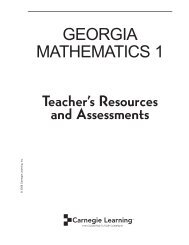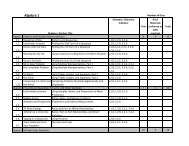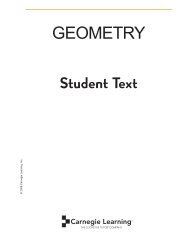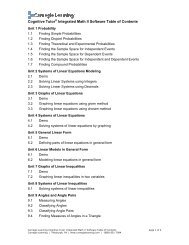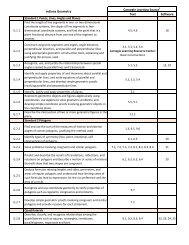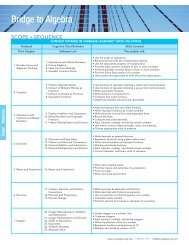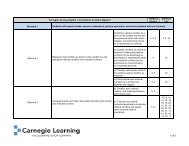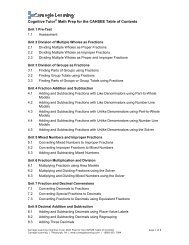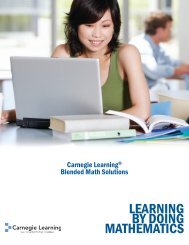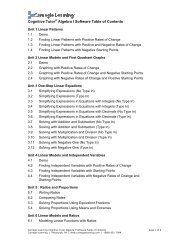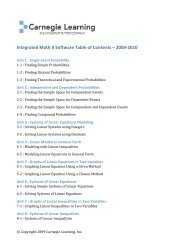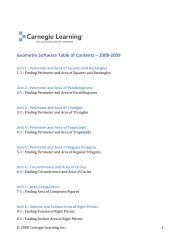KY Algebra 1.XLS - Carnegie Learning
KY Algebra 1.XLS - Carnegie Learning
KY Algebra 1.XLS - Carnegie Learning
You also want an ePaper? Increase the reach of your titles
YUMPU automatically turns print PDFs into web optimized ePapers that Google loves.
CORRELATIONS<br />
Grade Level: <strong>Algebra</strong> 1<br />
Course: <strong>Algebra</strong> 1<br />
Kentucky Standard <strong>Algebra</strong> I Text Lessons <strong>Algebra</strong> I Software Units<br />
Number Properties and Operations: High school students should enter high school with a strong background in rational numbers and<br />
numerical operations and expand this to real numbers. This becomes the foundation for algebra and working with algebraic symbols. They<br />
understand large and small numbers and their representations, powers and roots. They compare and contrast properties of numbers and<br />
number systems and develop strategies to estimate the results of operations on real numbers. Students will use, and understand the<br />
limitations of, graphing calculators and computer spreadsheets appropriately as learning tools.<br />
Number Sense<br />
MA-HS-1.1.1: Students will compare real numbers using order<br />
relations (less than, greater than, equal to) and represent problems<br />
using real numbers. 13<br />
MA-HS-1.1.2: Students will demonstrate the relationships between<br />
different subsets of the real number system. 4.5 13<br />
MA-HS-1.1.3: Students will use scientific notation to express very<br />
large or very small quantities. 9.4 29<br />
Estimation<br />
MA-HS-1.2.1: Students will estimate solutions to problems with real<br />
numbers (including very large and very small quantities) in both real-<br />
world and mathematical ti problems, and use the estimations to check<br />
for reasonable computational results.<br />
1.9, 3.8 25.2<br />
Number Operations<br />
MA-HS-1.3.1: Students will solve real-world and mathematical<br />
problems to specified accuracy levels by simplifying expressions with<br />
real numbers involving addition, subtraction, multiplication, division,<br />
absolute value, integer exponents, roots (square, cube) and<br />
factorials.<br />
1.1, 1.2, 1.3, 1.4, 1.6, 1.7, 1.8, 1.9, 1.10, 3.6,<br />
9.1, 9.2, 9.3, 9.5, 9.6, 10.1, 10.2, 10.3, 10.4,<br />
10.6 1, 2, 3, 4, 5<br />
MA-HS-1.3.2: Students will describe and extend arithmetic and<br />
geometric sequences, determine a specific term of a sequence given<br />
an explicit formula, determine an explicit rule for the nth term of an<br />
arithmetic sequence, and apply sequences to solve real-world<br />
problems. 1.1, 1.2, 1.3, 1.4, 1.5 1<br />
MA-HS-1.3.3: Students will write an explicit rule for the nth term of a<br />
geometric sequence.
CORRELATIONS<br />
Grade Level: <strong>Algebra</strong> 1<br />
Course: <strong>Algebra</strong> 1<br />
Kentucky Standard <strong>Algebra</strong> I Text Lessons <strong>Algebra</strong> I Software Units<br />
MA-HS-1.3.4: Students will recognize and solve problems that can<br />
be modeled using a finite geometric series, such as home mortgage<br />
problems and other compound interest problems. 5.8<br />
Ratios and Proportional Reasoning<br />
MA-HS-1.4.1: Students will apply ratios, percents and proportional<br />
reasoning to solve real-world problems (e.g., those involving slope<br />
and rate, percent of increase and decrease) and will explain how<br />
slope determines a rate of change in linear functions representing<br />
real-world problems. 2.1, 2.1, 2.3, 2.4, 2.5, 2.6, 2.7 2, 6, 7<br />
Properties of Numbers and Operations<br />
MA-HS-1.5.1: Students will identify real number properties<br />
(commutative properties of addition and multiplication, associative<br />
properties of addition and multiplication, distributive property of<br />
multiplication over addition and subtraction, identity properties of<br />
addition and multiplication and inverse properties of addition and<br />
multiplication) when used to justify a given step in simplifying an<br />
expression or solving an equation.<br />
3.1, 4.4, 4.5 4, 8, 10, 11, 12, 18<br />
MA-HS-1.5.2: Students will use equivalence relations (reflexive,<br />
symmetric, transitive). 3.1 4, 8, 10, 11, 12, 18<br />
Measurement: High school students continue to measure and estimate measurements including fractions and decimals. They use formulas<br />
to find surface area and volume. They use US Customary and metric units of measurement. They use the Pythagorean theorem and other<br />
right triangle relationships to solve real-world problems.<br />
Measuring Physical Attributes<br />
MA-HS-2.1.1: Students will determine the surface area and volume<br />
of right rectangular prisms, pyramids, cylinders, cones and spheres<br />
in real-world and mathematical problems.<br />
MA-HS-2.1.2: Students will describe how a change in one or more<br />
dimensions of a geometric figure affects the perimeter, area and<br />
volume of the figure. 9.5
Shapes and Relationships<br />
MA-HS-3.1.1: Students will analyze and apply spatial relationships<br />
(not using Cartesian coordinates) among points, lines and planes<br />
(e.g., betweenness of points, midpoint, segment length, collinear,<br />
coplanar, parallel, perpendicular, skew).<br />
CORRELATIONS<br />
Grade Level: <strong>Algebra</strong> 1<br />
Course: <strong>Algebra</strong> 1<br />
Kentucky Standard <strong>Algebra</strong> I Text Lessons <strong>Algebra</strong> I Software Units<br />
MA-HS-2.1.3: Students will apply definitions and properties of right<br />
triangle relationships (right triangle trigonometry and the<br />
Pythagorean theorem) to determine length and angle measures to<br />
solve real-world and mathematical problems. 13.1 37<br />
MA-HS-2.1.4: Students will apply special right triangles and the<br />
converse of the Pythagorean theorem to solve real-world problems.<br />
13.1 37<br />
Systems of Measurements<br />
MA-HS-2.2.1: Students will continue to apply to both real-world and<br />
mathematical problems U.S. customary and metric systems of<br />
measurement. 6.1, 13.1 2<br />
Geometry: High school students expand analysis of two-dimensional shapes and three-dimensional shapes. They translate shapes in a<br />
coordinate plane. They extend work with congruent and similar figures, including proportionality.<br />
MA-HS-3.1.2: Students will use spatial relationships to prove basic<br />
theorems.<br />
MA-HS-3.1.3: Students will analyze and apply angle relationships<br />
(e.g., linear pairs, vertical, complementary, supplementary,<br />
corresponding and alternate interior angles) in real-world and<br />
mathematical problems.<br />
MA-HS-3.1.4: Students will use angle relationships to prove basic<br />
theorems.<br />
MA-HS-3.1.5: Students will classify and apply properties of twodimensional<br />
geometric figures (e.g., number of sides, vertices,<br />
length of sides, sum of interior and exterior angle measures).<br />
MA-HS-3.1.6: Students will know the definitions and basic properties<br />
of a circle and will use them to prove basic theorems and solve<br />
problems.<br />
13.2 38
CORRELATIONS<br />
Grade Level: <strong>Algebra</strong> 1<br />
Course: <strong>Algebra</strong> 1<br />
Kentucky Standard <strong>Algebra</strong> I Text Lessons <strong>Algebra</strong> I Software Units<br />
MA-HS-3.1.7: Students will solve real-world and mathematical<br />
problems by applying properties of triangles (e.g., Triangle Sum<br />
theorem and Isosceles Triangle theorems).<br />
MA-HS-3.1.8: Students will use the properties of triangles to prove<br />
basic theorems.<br />
MA-HS-3.1.9: Students will classify and apply properties of threedimensional<br />
geometric figures.<br />
MA-HS-3.1.10: Students will describe the intersection of a plane with<br />
a three-dimensional figure.<br />
MA-HS-3.1.11: Students will visualize solids and surfaces in threedimensional<br />
space when given two-dimensional representations<br />
(e.g., nets, multiple views) and create two-dimensional<br />
representations for the surfaces of three-dimensional objects.<br />
MA-HS-3.1.12: Students will apply the concepts of congruence and<br />
similarity to solve real-world and mathematical problems.<br />
MA-HS-3.1.13: Students will prove triangles congruent and similar.<br />
Transformations of Shapes<br />
MA-HS-3.2.1: Students will identify and describe properties of and<br />
apply geometric transformations within a plane to solve real-world<br />
and mathematical problems.<br />
Coordinate Geometry<br />
MA-HS-3.3.1: Students will apply algebraic concepts and graphing in<br />
the coordinate plane to analyze and solve problems (e.g., finding the<br />
final coordinates for a specified polygon, midpoints, betweenness of<br />
points, parallel and perpendicular lines, the distance between two<br />
points, the slope of a segment).<br />
Foundational Statements<br />
MA-HS-3.4.1: Students will identify definitions, axioms and theorems,<br />
explain the necessity for them and give examples of them.<br />
13.2 14, 38,
CORRELATIONS<br />
Grade Level: <strong>Algebra</strong> 1<br />
Course: <strong>Algebra</strong> 1<br />
Kentucky Standard <strong>Algebra</strong> I Text Lessons <strong>Algebra</strong> I Software Units<br />
MA-HS-3.4.2: Students will recognize that there are geometries,<br />
other than Euclidean geometry, in which the parallel postulate is not<br />
true.<br />
MA-HS-3.4.3: Students will be able to perform constructions such as<br />
a line parallel to a given line through a point not on the line, the<br />
perpendicular bisector of a line segment and the bisector of an<br />
angle.<br />
Data Analysis and Probability: High school students extend data representations, interpretations and conclusions. They describe data<br />
distributions in multiple ways and connect data gathering issues with data interpretation issues. They relate curve of best fit with twovariable<br />
data and determine line of best fit for a given set of data. They distinguish between combinations and permutations and compare<br />
and contrast theoretical and experimental probability.<br />
Data Representations<br />
MA-HS-4.1.1: Students will analyze and make inferences from a set<br />
of data with no more than two variables, and will analyze problems<br />
for the use and misuse of data representations. 11.1, 11.2, 11.3, 11.4, 11.5, 11.6, 11.7 35<br />
MA-HS-4.1.2: Students will construct data displays for data with no<br />
more than two variables. 11.1, 1 11.2, 11.3, 11.4, 11.5, 11.6, 11.7 35<br />
MA-HS-4.1.3: Students will represent real-world data using matrices<br />
and will use matrix addition, subtraction, multiplication (with matrices<br />
no larger than 2x2) and scalar multiplication to solve real-world<br />
problems.<br />
Characteristics of Data Sets<br />
MA-HS-4.2.1: Students will describe and compare data distributions<br />
and make inferences from the data based on the shapes of graphs,<br />
measures of center (mean, median, mode) and measures of spread<br />
(range, standard deviation). 12.1, 12.2, 12.4 36<br />
MA-HS-4.2.2: Students will know the characteristics of the Gaussian<br />
normal distribution (bell-shaped curve).<br />
MA-HS-4.2.3: Students will identify an appropriate curve of best fit<br />
(linear, quadratic, exponential) for a set of two-variable data,<br />
determine a line of best fit equation for a set of linear two-variable<br />
data, and apply a line of best fit to make predictions within and<br />
beyond a given set of two-variable data. 6.1, 6.2, 6.3, 6.4, 6.5, 6.6, 6.7
CORRELATIONS<br />
Grade Level: <strong>Algebra</strong> 1<br />
Course: <strong>Algebra</strong> 1<br />
Kentucky Standard <strong>Algebra</strong> I Text Lessons <strong>Algebra</strong> I Software Units<br />
MA-HS-4.2.4: Students will recognize when arguments based on<br />
data confuse correlation and causation. 6.4<br />
Experiments and Samples<br />
MA-HS-4.3.1: Students will recognize potential for bias resulting from<br />
the misuse of sampling methods (e.g., non-random sampling, polling<br />
only a specific group of people, using limited or extremely small<br />
sample sizes) and explain why these samples can lead to inaccurate<br />
inferences. 2.1<br />
MA-HS-4.3.2: Students will design simple experiments or<br />
investigations to collect data to answer questions of interest. 2.1, 6.3, 6.5, 6.6<br />
MA-HS-4.3.3: Students will explain the differences between<br />
randomized experiments and observational studies. 2.1<br />
Probability<br />
MA-HS-4.4.1: Students will determine theoretical and experimental<br />
(from given data) probabilities, make predictions and draw<br />
inferences from probabilities, compare theoretical and experimental<br />
probabilities, and determine probabilities involving replacement and<br />
non-replacement. 11.1, 11.2, 11.3, 11.5, 11.6, 11.7 35<br />
MA-HS-4.4.2: Students will recognize and identify the differences<br />
between combinations and permutations and use them to count<br />
discrete quantities. 11.6 35<br />
MA-HS-4.4.3: Students will represent probabilities in multiple ways,<br />
such as fractions, decimals, percentages and geometric area<br />
models. 2.1, 11.1, 11.2, 11.3, 11.4, 11.5, 11.6, 11.7 35<br />
MA-HS-4.4.4: Students will explain how the law of large numbers<br />
can be applied in simple examples.<br />
<strong>Algebra</strong>ic Thinking: High school students extend analysis and use of functions and focus on linear, quadratic, absolute value and<br />
exponential functions. They explore parametric changes on graphs of functions. They use rules and properties to simplify algebraic<br />
expressions. They combine simple rational expressions and combine simple polynomial expressions. They factor polynomial expressions<br />
and quadratics of the form 1x^2 + bx +c.<br />
Patterns, Relations and Functions
CORRELATIONS<br />
Grade Level: <strong>Algebra</strong> 1<br />
Course: <strong>Algebra</strong> 1<br />
Kentucky Standard <strong>Algebra</strong> I Text Lessons <strong>Algebra</strong> I Software Units<br />
MA-HS-5.1.1: Students will identify multiple representations (tables,<br />
graphs, equations) of functions (linear, quadratic, absolute value,<br />
exponential) in real-world or mathematical problems.<br />
Chapters 1, 2, 3, 4, 5, 6, 7, 8, 13<br />
Throughout the tutor<br />
MA-HS-5.1.2: Students will identify, relate and apply representations<br />
(graphs, equations, tables) of a piecewise function (such as long<br />
distance telephone rates) from mathematical or real-world<br />
information. 5.6<br />
MA-HS-5.1.3: Students will demonstrate how equations and graphs<br />
are models of the relationship between two real-world quantities<br />
(e.g., the relationship between degrees Celsius and degrees<br />
Fahrenheit). Chapters 1, 2, 3, 4, 5, 6, 7, 8, 13 Throughout the tutor<br />
MA-HS-5.1.4: Students will recognize and solve problems that can<br />
be modeled using an exponential function, such as compound<br />
interest problems. 13.6, 13.7 40<br />
MA-HS-5.1.5: Students will determine if a relation is a function,<br />
determine the domain and range of a function (linear and quadratic),<br />
determine the slope and intercepts of a linear function, determine the<br />
maximum, minimum, and intercepts (roots/zeros) of a quadratic<br />
function, and evaluate a function written in function notation for a<br />
specified rational number.<br />
4.2, 4.3, 4.4, 4.5, 5.1, 5.2, 5.3, 5.4, 5.5, 5.6,<br />
5.7, 5.8, 8.1, 8.2, 8.5, 8.6, 8.7, 8.8 14, 20, 21, 24, 26, 27<br />
MA-HS-5.1.6: Students will find the domain and range for absolute<br />
value functions. 4.7<br />
MA-HS-5.1.7: Students will apply and use direct and inverse<br />
variation to solve real-world and mathematical problems. 2.5 (direct variation) 7<br />
MA-HS-5.1.8: Students will identify the changes and explain how<br />
changes in parameters affect graphs of functions (linear, quadratic,<br />
absolute value, exponential) (e.g., compare y = x2, y = 2x2, y = (x-<br />
4)2, and y = x2+3). 13.5 39<br />
Variables, Expressions, and Operations<br />
MA-HS-5.2.1: Students will apply order of operations, real number<br />
properties (identity, inverse, commutative, associative, distributive,<br />
closure) and rules of exponents (integer) to simplify algebraic<br />
expressions. 1.2, 4.5<br />
4, 8, 10, 11, 12, 18, 19, 28, 29, 30,<br />
31, 32
CORRELATIONS<br />
Grade Level: <strong>Algebra</strong> 1<br />
Course: <strong>Algebra</strong> 1<br />
Kentucky Standard <strong>Algebra</strong> I Text Lessons <strong>Algebra</strong> I Software Units<br />
MA-HS-5.2.2: Students will evaluate polynomial and rational<br />
expressions and expressions containing radicals and absolute<br />
values at specified values of their variables. 10.1, 10.2, 10.3, 10.4, 10.5, 10.6 32, 34,<br />
MA-HS-5.2.3: Students will add, subtract and multiply polynomial<br />
expressions, factor polynomial expressions using the greatest<br />
common monomial factor, factor quadratic polynomials of the form<br />
ax2 + bx + c, when a = 1 and b and c are integers.<br />
10.1, 10.2, 10.3, 10.4, 10.5, 10.6 24, 27, 32, 33<br />
MA-HS-5.2.4: Students will factor quadratic polynomials, such as<br />
perfect square trinomials and quadratic polynomials of the form<br />
ax^2+bx=c when a1 and b and c are integers. 10.5 33<br />
MA-HS-5.2.5: Students will add, subtract, multiply and divide simple<br />
rational expressions with monomial first-degree denominators and<br />
integer numerators (e.g., 3/5x+4/3y; 9/2a--7/4b; 3/-5x*-4/7y; 5/2c div<br />
9/-11d), and will express the results in simplified form.<br />
10.5 34<br />
Equations and Inequalities<br />
MA-HS-5.3.1: Students will model, solve and graph first degree,<br />
single variable equations and inequalities, including absolute value,<br />
based in real-world and mathematical problems and graph the<br />
solutions on a number line. 3,1, 3.2, 3.3, 3.4, 3.5, 4.1, 4.6, 4.7<br />
4, 8, 10, 11, 19, (No absolute<br />
value or inequalities)<br />
MA-HS-5.3.2: Students will solve for a specified variable in a<br />
multivariable equation. 5.8 18<br />
MA-HS-5.3.3: Students will model, solve and graph first degree, twovariable<br />
equations and inequalities in real-world and mathematical<br />
problems. Chapters 1, 2, 3, 4, 5 3, 5, 7, 9, 12, 14, 15, 16, 17, 22<br />
MA-HS-5.3.4: Students will model, solve and graph systems of two<br />
linear equations in real-world and mathematical problems. 1.10, 7.1, 7.2, 7.3, 7.4, 7.5, 7.6, 7.7, 7.8 20, 21<br />
MA-HS-5.3.5: Students will write, graph, and solve systems of two<br />
linear inequalities based on real-world or mathematical problems<br />
and interpret the solution. 7.9 23<br />
MA-HS-5.3.6: Students will model, solve and graph quadratic<br />
equations in real-world and mathematical problems. 8.1, 8.2, 8.3, 8.7, 8.8 24. 26. 27. 33, 39




